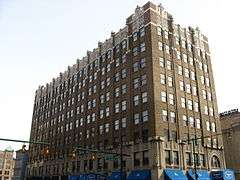Cleveland, Cincinnati, Chicago and St. Louis Railway
.svg.png) Big Four (red) and New York Central system (orange) as of 1918 | |
| Locale | Illinois, Indiana, Michigan, and Ohio |
|---|---|
| Dates of operation | 1889–1930 |
| Successor | New York Central |
| Track gauge | 4 ft 8 1⁄2 in (1,435 mm) standard gauge |
| Headquarters | Indianapolis, Indiana |
The Cleveland, Cincinnati, Chicago and St. Louis Railway, also known as the Big Four Railroad and commonly abbreviated CCC&StL, was a railroad company in the Midwestern United States. It operated in affiliation with the New York Central system.
Its primary routes were in Illinois, Indiana, Michigan, and Ohio. At the end of 1925 it reported 2391 route-miles and 4608 track-miles; that year it carried 8180 million net ton-miles of revenue freight and 488 million passenger-miles.
History
The railroad was formed on June 30, 1889 by the merger of the Cleveland, Columbus, Cincinnati and Indianapolis Railway, the Cincinnati, Indianapolis, St. Louis and Chicago Railway and the Indianapolis and St. Louis Railway. The following year, the company gained control of the former Indiana, Bloomington and Western Railway (through the foreclosed Ohio, Indiana and Western Railway and through an operating agreement with the Peoria and Eastern Railway).
In 1906 the Big Four was acquired by the New York Central Railroad, which operated it as a separate entity until around 1930. The Big Four's lines were later incorporated into Penn Central in 1968 with the merger of New York Central and the Pennsylvania Railroad. Penn Central declared bankruptcy in 1970, and in 1976 many of Big Four's lines were included in the government-sponsored Conrail. Conrail was privatized in 1987 and in 1997 was jointly acquired by CSX and Norfolk Southern.
Notable facilities

The railroad was headquartered in Indianapolis, Indiana, in the Chesapeake Building at 105 S. Meridian Street. The building was constructed for the railroad in 1929 and was also known as the Big Four Building. In 2007 this multi-story structure became a Hampton Inn hotel.[1]
On the southwest corner of Pennsylvania and Georgia streets in the Wholesale District of downtown Indianapolis, a large building was built by the railroad as one of its maintenance shops. Until the neighboring Conseco Fieldhouse was constructed in the late 1990s, an elevated track crossed Pennsylvania Street into a partially open locomotive service bay, which remains visible along the south side of the second story of this still standing structure. During the Conrail era most of the building was used as office space; its successor, CSX, still uses a portion of this Georgia Street facility.
Between 1904 and 1908 the railroad constructed a repair shop for steam locomotives, and passenger and freight cars in Beech Grove, Indiana. Amtrak purchased the facility, now known as the Beech Grove Shops, from the bankrupt Penn Central in 1975.[2]
The railroad once operated a terminal at Bellefontaine, Ohio which included the largest roundhouse in use at that time between New York City and St. Louis, Missouri. Conrail closed the Bellefontaine terminal in 1983, and its roundhouse was dismantled.
A large yard facility known as Big Four Yards is located in Avon, Indiana along the line's tracks, now owned and operated by CSX.
In 1895 the railroad acquired what became known as the Big Four Bridge across the Ohio River at Louisville, Kentucky, thereby giving it access to that city. Use of the bridge for railroad purposes ceased by 1968, and it sat abandoned until work began by 2006 to convert it to use by pedestrians and bicyclists.[3]
See also
- Purdue Wreck — 1903 train collision
References
- ↑ Hampton Inn - Downtown Indianapolis
- ↑ Amtrak (August 27, 2012). "Beech Grove shops". Retrieved May 22, 2016.
- ↑ Kleber, John E. (2000). Encyclopedia of Louisville. University Press of Kentucky. p. 89. ISBN 0813121000.
External links
- History of The Cleveland Cincinnati Chicago and St Louis Railway and its predecessors from the 1913 Annual Report of The New York Central Railroad System.
- Columbus, Ohio Railroads history page